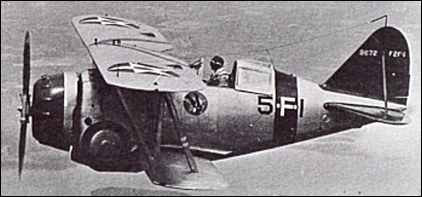|
| Developed from the FF-1, the XF2F-1 prototype single-seat carrier-borne biplane fighter made its first flight just a few months after deliveries began of the earlier type. In terms of performance it was a great improvement over naval fighters then operational and so the US Navy ordered it into production. The F2F-1 production version was powered by the 484.4kW Pratt & Whitney R-1535-72 radial engine, had a neat cockpit canopy which was faired into the rear fuselage and retained the type of retractable landing gear used on the FF-1.
Soon after all F2F-1 had been delivered, Grumman produced a new prototype, the XF3F-1, which flew for the first time in March 1935. This version was slightly larger and production aircraft entered service in the following year. F3F-1 and later F3F-2 were powered by 484.4kW R-1535-84 and 559kW Wright Cyclone engines respectively, although in general construction they were identical to the F2F-1. Maximum level speed of the F3F-2 was 434.5km/h, a clear
48km/h faster than the F3F-1. Altogether a total of 216 F2F/F3F were produced, remaining operational until the latter part of 1939.
 | A three-view drawing (1278 x 984) |
| MODEL | F2F-1 |
| CREW | 1 |
| ENGINE | 1 x Pratt-Whitney R-1535-72 Twin Wasp, 485kW |
| WEIGHTS |
| Take-off weight | 1745 kg | 3847 lb |
| Empty weight | 1221 kg | 2692 lb |
| DIMENSIONS |
| Wingspan | 8.69 m | 29 ft 6 in |
| Length | 6.53 m | 21 ft 5 in |
| Height | 2.77 m | 9 ft 1 in |
| Wing area | 21.37 m2 | 230.02 sq ft |
| PERFORMANCE |
| Max. speed | 383 km/h | 238 mph |
| Cruise speed | 225 km/h | 140 mph |
| Range | 1585 km | 985 miles |
| ARMAMENT | 2 x 7.62mm machine-guns |
| Klaatu83, e-mail, 16.12.2012 18:02 Compare this with the same company's earlier FF-1 two-seat fighter. The two-seat fighter concept derived from the success of Britain's Bristol Fighter during World War I, and the formula remained popular through the 1920s and into the early 1930s. The fact that the U.S. Navy became disenchanted with the concept was indicated by the rapid replacement of the FF-1 by the single-seat F2F, and the change in designation from FF-1 to SF-1, indicating the airplane's change in role to reconnaissance. reply | | Mike Davis, e-mail, 15.12.2010 23:38 I believe the pilot is the squadron commander of Fighting Five on the first USS Yorktown (lost at Battle of Midway), then LCDR William L. Rees USNA '20 /'21 (1900-1989?). The photo was taken over the Norfolk, VA, area. Rees retired in 1960 as VADM, COMAIRLANT. reply | | Bill Parker, e-mail, 09.11.2010 00:41 I have a fairly decent plan for the F2F here. It's from American Modeler Magazine 1957... Send me a note and I'll send you a copy to look at. reply | | Michael Titone, e-mail, 16.04.2010 22:40 Does anyone know where I can optain an upscale version of this model to build for display only (modelbuilding)
I tried Trumpeter, but they don't seem to have the model. reply | |
| | Glenn, e-mail, 03.04.2009 07:57 This is one of the worst airplanes;if you can call it that!! Our idiots in washington and in the armed services didn't know planes worth a damn to save thier miserable reputations and would get our boys killed in those death traps!! reply | | Scott Davis, e-mail, 04.10.2008 22:41 Hi, Scott Davis of salt lake city UT.this airplane is to be my next radio control project in 1 /3 scale, because of its complexity and the way cool landing geartotal build time to fly time may be as long as two to three years. Lots more work being done in the winter mo.Please respond if you have any photos or fabrication prints detailing the landing gear as this is the most challenging asspict of this project!!! Sincerly Scott Davis reply |
|
Do you have any comments?
|
| 
COMPANY
PROFILE
All the World's Rotorcraft
|







